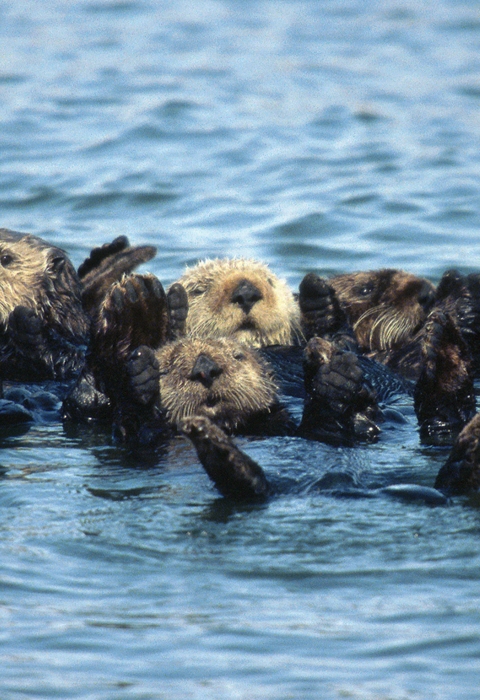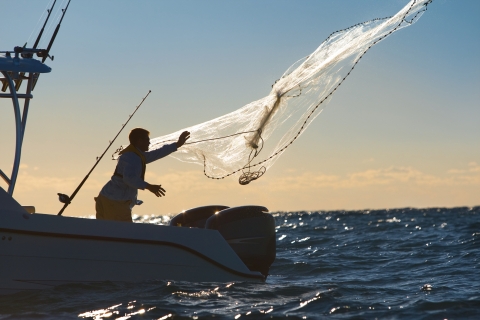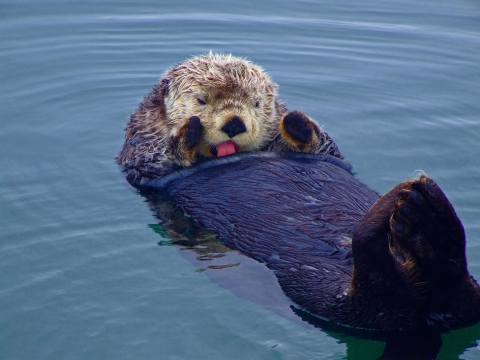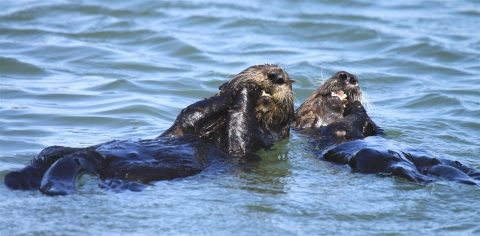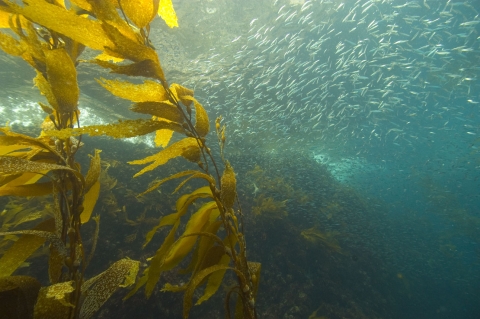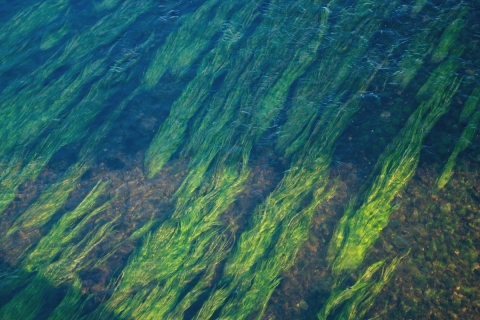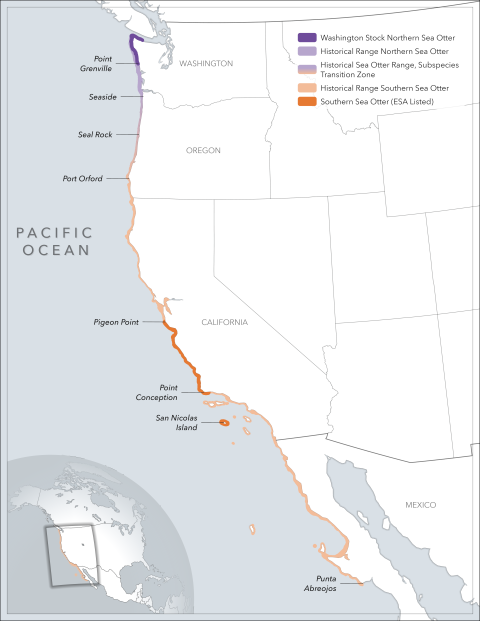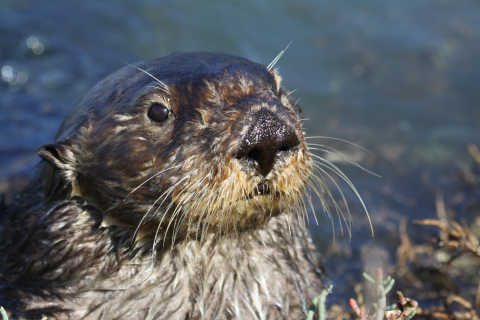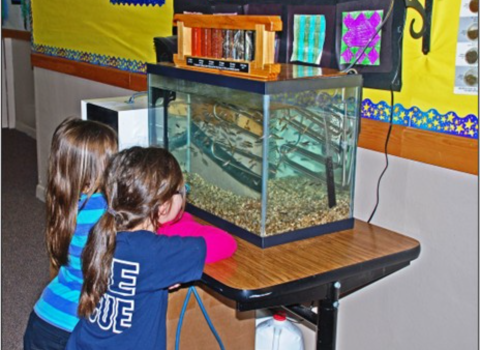Sea Otters are an Ecosystem Hero
This federally protected species isn’t just an adorable, charismatic, swimming furball, it also plays an essential role in maintaining nearshore ecosystems. All living things are interdependent upon one another and some, like the sea otter, are considered a keystones species because they play an essential role in maintaining ecosystem balance. A keystone species is like the top stone (i.e., the keystone) of a rock arch – if that stone gets removed, the entire arch collapses. This is what happens to the kelp forest and seagrass ecosystems that sea otters help protect. When combined with a number of factors like warming water and a reduction of other natural predators like sea stars due to sea star wasting disease, these ecosystems can collapse without their keystone species to support them. The shelter, food, and habitat these two environments offer in the nearshore community support thousands of different life forms including fish, crabs, mollusks, marine mammals, birds, and humans.
Eating Machines
Sea otters are classified as a “marine mammal” because they spend most of their life in the ocean and rarely come ashore. They eat, sleep, and even give birth at sea. While they simply go about their daily lives, sea otters help us by reducing the impacts of climate change climate change
Climate change includes both global warming driven by human-induced emissions of greenhouse gases and the resulting large-scale shifts in weather patterns. Though there have been previous periods of climatic change, since the mid-20th century humans have had an unprecedented impact on Earth's climate system and caused change on a global scale.
Learn more about climate change – and they are perfectly suited for this task. Unlike most marine mammals, including whales and seals, sea otters don’t have a layer of blubber to insulate them from the cold Pacific Ocean water. Instead, they have very thick fur with up to a million hairs per square inch - the densest fur of any animal. We humans only have about 100,000 hairs on our entire head – so just one square inch of sea otter fur is equivalent to around 10 human heads of hair! A trapped layer of air is very important for keeping cold water from contacting their skin; without it, sea otters quickly become hypothermic. This is why they are often seen grooming on the surface of the water, puffing up their fur and trapping more air. Mother otters groom their pups constantly and literally blow air bubbles into their fur to make sure they stay warm. This also makes their young babies (those under 6 weeks old) so buoyant that they can't dive and will pop up to the surface like a cork. In addition to their thick fur, sea otters have a high metabolism they need to fuel by eating a lot - as much as 25% to 30% of their body weight every day. Lactating mothers need to eat twice that amount. Sea urchins, abalone, clams, mussels, crabs, snails, sea stars, octopus, and squid are some of the many species on the sea otter’s menu. When it comes to supporting the health of kelp forests and seagrasses, both of which play an essential role in removing carbon from the atmosphere, the sea otter's need to regularly feast is necessary.
Sea Otters are Climate Change Helpers through their Protection of Kelp Forest and Seagrasses
Sea urchins are one of the sea otter’s favorite foods, which is good news for kelp forests because sea urchins eat a lot of kelp. When sea urchin populations go unchecked due to a lack of natural predators, the urchins’ voracious appetite for kelp can turn the bottom of the nearshore ocean into an underwater desert. A 20-year UC Santa Cruz study has shown that the kelp canopy along the 217-mile coastline between San Francisco and the Oregon border is down more than 90% because of the combined effects of a marine heat wave and the overpopulation of purple sea urchins. The absence of sea otters, along with sea star wasting syndrome – a deadly disease that wiped out sea stars in 2013 – are the primary causes of the overpopulation of urchins (sea stars are another urchin predator). Kelp forests, like terrestrial forests, absorb a lot of carbon dioxide from the atmosphere. Unlike land forests, kelp grows incredibly fast (up to two feet per day!) and in so doing, can absorb and remove carbon from the atmosphere. A healthy, intact kelp forest can absorb up to 20 times more carbon per acre than forests on land. With sea urchins on the menu, the protection sea otters provide kelp forests is essential. Studies have shown a kelp forest without sea otters can capture 4.4 megatons of carbon dioxide, whereas a kelp forest with otter protection can capture nearly twice as much at 8.7 megatons. (Learn more: Harvard blog on how sea kelp stores carbon)
The presence of sea otters also supports diverse and healthy seagrasses, another important nearshore community that helps combat climate change. Here’s what researchers discovered in California’s Elkhorn Slough: sea otters eat crabs which eat creatures like sea hares. Sea hares look a bit like ocean slugs, and they eat algae that grows on seagrass. Too much algae smothers and kills seagrasses. Therefore, the sea otter’s important role of regulating crab populations in the seagrass environment has a cascading effect on the health of the entire ecosystem by supporting more algae-eating sea hares. The vast, underwater meadows and deep root systems of seagrass beds represent less than 0.2% of the seafloor, but they provide up to 10% of the ocean’s carbon storage! Though the amount of storage varies by species, some seagrasses can store three to five times as much carbon per equivalent area as tropical forests! (Learn more: Role of seagrass beds in in Carbon Storage)
On the flip side, human-caused release of carbon dioxide into the atmosphere has greatly increased acidity levels in the ocean. Carbon doesn’t just stay in the air – 30% to 50% of it is absorbed into the ocean. As it gets absorbed, it makes the water more acidic, which is called “ocean acidification.” In the last 150 years, the ocean’s acidity has increased by nearly 30%! Animals that have calcium-based shells like clams, mussels, crabs, snails, and oysters can be impacted by increased acidity in the ocean, especially during their fragile larval stages. Their shells literally dissolve and become thinner or weaker, making survival more challenging. Ocean acidification poses a risk to all who depend on these shelled creatures, including the commercial shellfish industry, sea otters, and other animals. This makes the rapid growth, photosynthesis and carbon storage of kelp forests and seagrasses that flourish in the presence of otters so important because they also locally reduce ocean acidification by storing and removing the acidifying carbon from the water.
Working to Recover Sea Otters
Historically, sea otters lived all along the coasts of the North Pacific Ocean from northern Japan to Russia, Alaska, Canada, Washington, Oregon, California, and Baja California in Mexico. Starting in the early 1700s, their beautiful, thick fur became a luxury commodity in the fur trade industry and nearly led to their extinction. Before the fur trade their populations were estimated at up to 300,000 individuals across their range. Traders hunted so many sea otters that by the early 1900s there were only about 13 remnant populations of 2,000 sea otters left in the world scattered throughout their historical range. The remaining populations in the United States were located in southwest and southcentral Alaska, with a single small population in Central California. In 1911, the United States, Canada, Russia, and Japan banded together to protect the remaining populations by signing the Northern Pacific Fur Seal Treaty, which prohibited hunting sea otters in international waters. Today, there are other laws that have been added to protect this important animal like the Marine Mammal Protection Act and, for the southern (California) sea otter and the southwest distinct population segment of the northern sea otter, the Endangered Species Act.
Thanks to many conservation efforts, including past reintroduction efforts that are responsible for about 30% of the existing global sea otter population, their numbers have increased significantly since 1911. But California’s southern sea otter population numbers only around 3,000 and is still found in just a tiny fraction of its original range. About 50 years ago, northern sea otters were reintroduced to Washington and Oregon from Alaska populations. They were also reintroduced into several areas in Alaska and Canada. The reintroduced populations in Alaska, Canada, and Washington took hold and are steadily growing, but the population in Oregon disappeared. Although a lone sea otter may visit Oregon’s coastline now and then, these animals are not permanent residents. There is a more than 900-mile gap along the coastline between central California and the west coast of Washington where there still are no sea otters. In the face of a rapidly changing climate, do we have the time to wait for natural recolonization? Restoring sea otters throughout their historical range would give them the greatest chance of surviving climate change, and it would help to sequester carbon and strengthen the resilience of nearshore ecosystems.
Like Sea Otters, We All Have an Important Role to Play in Combatting Climate Change!
Ensuring the presence of sea otters in Pacific coast nearshore ecosystems is one of many important ways we can combat climate change, but we cannot count on sea otters alone. Through the day-to-day choices we all make, we too must play a role. We need to keep making individual decisions that reduce our carbon footprint, like reducing our energy use, taking public transit, walking or biking instead of driving, choosing a mostly plant-based diet, consuming less, and recycling or re-using more. But coming together collectively is where most of our power resides. We can:
Work to protect, restore and conserve natural areas and marine habitats, recognizing that we all have a stake in preserving ecosystem functioning and carbon sequestration, wherever we live.
Increase our land-based natural carbon storage capacity by volunteering with community groups to plant more trees in public areas, in our neighborhoods and at home.
Get involved in supporting sustainable urban planning by talking to our neighbors, civic associations, and local service groups to engage them in discussions around climate change aimed at collective action.
Remain civically engaged and act with conservation and climate change in mind.
Individually we can slow down climate change. Collectively, we can stop it. Our choices and actions today will support sea otter populations for generations to come. In turn, the presence of sea otters swimming freely returns the favor exponentially through the many positive effects they have on the environment, including the important role they play in helping us all combat climate change.
